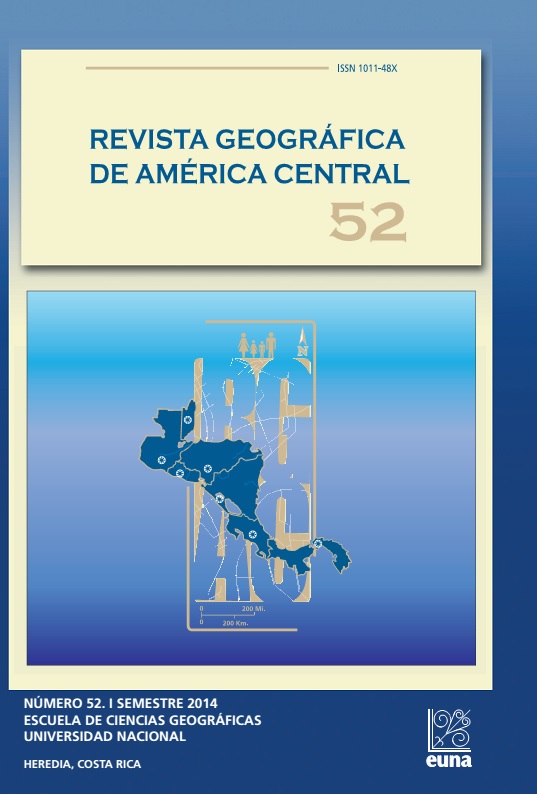CYBERSPACE AND THE POSSIBILITIES OF VISUALIZATION OF (AT LEAST) FOUR KINDS OF SPATIALITY
Keywords:
Space, spatiality, visualization, GIS technologiesAbstract
The options of visualization of spatialities grow with use of information and communication technologies (ICT). Four types of spatialities described according to Hynek and Vávra (2007) have been selected and tested for current ICT methods. The natural and socioeconomic spatialities could be easily visualized by geographical information systems (GIS) with addition to 3D modeling. Typical example is use of augmented reality technologies incorporated into mobile devices and mass delivered in ordinary use. Paper deals with the examples of visualization in each of the spatiality, critically discusses the potential and risks of computer-based tools used in visualization and proposes the suitable implementation in geographical sciences as well as possible transition among defined spatialities.
References
Aaltonen, A., Lehikoinen, J. (2006). Exploring augmented reality visualizations. In AVI ‚06 Proceedings of the working conference on Advanced visual interfaces. New York : ACM. p. 453 – 456. ISBN 1-59593-353-0
Abler, A. H. (2001). Geography: history and concepts. 3rd edition. Los Angeles: Sage.
Harvey, D. (1973). Social Justice and the City. Baltimore: Johns Hopkins University Press. Cloke, P. et al. (2005). Introducing human geographies. 2nd ed. London: Hodder Arnold.
GE Ecomagination. Ecomagination [online]. [cit. 6. 6. 2013]. Accesible en: http://ge.ecomagination.com/smartgrid/#/augmented_reality
Hynek, A. (2007). Humánní geografie ve studiu krajiny. In: Herber, V. (ed.): Fyzickogeografický sborník 4: Fyzická geografie teorie a aplikace. Brno: Masarykova universita. s. 7–13.
Hynek, A. & Vávra, J. (2007). (Přinejmenším) čtyři prostorovosti krajiny. In: Fyzickogeografický sborník 5 z 24. výroční konference fyzickogeografické sekce České geografické společnosti 13. a 14.února 2007 v Brně. Fyzická geografie- výzkum, vzdělávání, aplikace , ed.V.Herber, MU Brno, 2007, s. 7-14
Hynek, A. (2009a). Prostorovosti: místa, krajiny, regiony. Acta Geographica Universitatis Comenianae, 53, s. 79-90. Univerzita Komenského v Bratislave.
Hynek, A. (2009b). Studium kulturní krajiny. In. Herber, V. (ed.): Fyzická geografie a krajinná ekologie : příspěvky z 26. výroční konference Fyzickogeografické sekce České geografické společnosti konané 10. a 11. února 2009 v Brně. Brno: Masarykova univerzita, s. 16-23.
Hynek, A. (2009c). The Politics of Landscape on Regional and Local Levels. GeoScape. (4) 1, s. 10-27.
Kainz, W. (2008). Theory and Practice of Fuzzy Sets in GIS. In: Schiewe J., Michel U. (eds.), Geoinformatics paves the Highway to Digital Earth. On the occasion of the 60th birthday of Professor Manfred Ehlers, pp. 49–54.
Kitchin, R. (1998). Towards geographies of cyberspace. In: Progress in Human Geography. London: 1998. (22), Iss. 3; p. 385. ISSN 0309-1325 Kitchin, R. and Dodge, M. (2002).
The emerging geographies of cyberspace. In Johnston, R. J. et al. (eds.): Geographies of global change: remapping the world. 2nd edition. Blackwell Publishing, Malden, p. 340-354.
Kolejka, J. (2005). Digitální model krajiny – nástroj při realizaci výzkumných a aplikačních studií. Geografie–Sborník ČGS. (110) 4, s. 286-299.
Kraft, S. (2009). Doprava, rychlost a časoprostorová komprese. In Poštolka V. et al. (eds): Geodny Liberec 2008 - Sborník příspěvků. Liberec, 2009. 9 s. ISBN 978-80-7372-443-6. Latour, B. (2005).
Reassembling the social an introduction to actor-network-theory. Oxford: Clarendon.
Lynch, K. (1960). The image of the city. Cambridge, Mass.: MIT Press, 194 s. ISBN 0262120046. Maad, S. (2010). (eds.): Augmented Reality. In Tech : 2010. 230 p. ISBN 978-953-7619-69-5.
Michovský, P. (2009). KOMAS vzniká v Geodisu. GeoBusiness, 07+08, 2010, s. 11. Praha : Springwinter, s.r.o., ISSN 1802-4521.
Mitra, A. and Schwartz, R. L. (2001). From Cyber Space to Cybernetic Space: Rethinking the Relationship between Real and Virtual Spaces. In: Journal of Computer-Mediated Communication, (7), Iss. 1.
Murdoch, J. (2006). Post-structuralist Geography: A Relational Guide to space. London: Sage Publications. ISBN 9780761974246 QRME. Understanding a QR-code [online]. [cit. 7. 6. 2013]. Accesible en: http://www.qrme.co.uk/qr-code-resources/understanding-a-qrcode.html
Sanderson, K. (2009). Europe‘s Galileo project gains ground. Nature,(461), Iss. 7267, p. 1039. ISSN 0028-0836
Slocum, T. (2005). Thematic cartography and geographic visualization. 2nd ed. Upper Saddle River, N.J. : Pearson Prentice Hall, 2005. x, 518 p., ISBN 0-13-035123-7
Trávníček, J., Trojan, J. (2010). Changing Landscape in GIS Dynamization in Practice: Using Old Maps at Educational Project for Secondary School in South Moravia, Czech Republic. In: Proceedings of the 5th International Workshop on Digital Approaches in Cartographic Heritage. Vienna : Vienna University of Technology, 2010. od s. 565-575, 10 s.
Trojan, J. and Trávníček, J. (2010). Spatiality of functional units in rural landscape in the greater Brno area: Lipůvka-Lažany-Újezd. GeoScape,(5), Iss. 2. Ústí nad Labem : Jan Evangelista Purkyne University. ISSN 1802-1115.
V tisku. Youtube. QR code reading [online]. [cit. 8. 6. 2013]. Accesible en: http:// www.youtube.com/watch?v=zNxu36aVdNU
Downloads
How to Cite
Issue
Section
License
Proposed policy for journals offering Open Access
Authors publishing their works in the Journal acknowledge and agree to the following terms:
a) Authors retain the copyrights to their works and guarantee the Journal the right to be the first to publish their works, under the Creative Commons License Attribution-NonCommercial-ShareAlike 4.0 International, CC BY-NC-SA 4.0 International (https://creativecommons.org/licenses/by-nc-sa/4.0/deed.es), which allows others to share works upon complying with the acknowledgment of authorship and mention of the Journal as the original publisher of the work.
b) Authors are permitted to separately establish additional agreements for the non-exclusive distribution of the official edition of the work published in the Journal (for example, authors may desire to place the work in an institutional repository or incorporate it into a book that is to published elsewhere) so long they acknowledgment to recognize the Journal as the original publisher. The aforementioned additional agreements must respect the terms of the non-profit character and sharing philosophy of the original license (CC BY-NC-SA 4.0 International, https://creativecommons.org/licenses/by-nc-sa/4.0/deed.es).
c) Authors are encouraged to archive the post-print or editor/PDF version in Open Access repositories.






 REVGEO is licensed under https://creativecommons.org/licenses/by-nc-sa/4.0/deed.es
REVGEO is licensed under https://creativecommons.org/licenses/by-nc-sa/4.0/deed.es
.svg_4.png)

_(1).png)
_(1)_(1)_(1)_1.png)
(2)(1)(1)(1).png)
